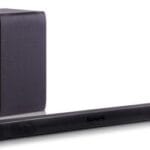Have you ever noticed water dripping from your furnace exhaust pipe and wondered what could be causing it? You’re not alone.
This seemingly minor issue can actually be a sign of something more significant. It might affect your furnace’s efficiency or even lead to more serious problems down the line. Understanding why this happens and knowing what you can do about it is crucial for maintaining a safe and comfortable home.
We’ll explore the reasons behind a dripping furnace exhaust pipe and guide you through simple solutions. You’ll gain the knowledge you need to keep your furnace running smoothly and avoid unnecessary hassles. Stay with us to uncover the facts and take control of your home’s comfort and safety.

Credit: www.instantplumbing.ca
Common Causes Of Dripping Water
Dripping water from your furnace exhaust pipe can be an annoying and potentially damaging issue. It’s not something you should ignore. Understanding the common causes can help you tackle the problem effectively. From condensation build-up to faulty installation, each cause requires a different solution. Let’s dive into what might be causing this watery dilemma.
Condensation Build-up
Condensation is a frequent culprit behind dripping water from furnace exhaust pipes. As warm air exits the furnace, it meets cooler air, causing moisture to condense. Over time, this condensation can accumulate and start dripping. Are you noticing frequent puddles near your furnace? You might have a condensation problem on your hands. Consider insulating the exhaust pipe to reduce the temperature difference and minimize condensation.
Faulty Installation
A poorly installed furnace can lead to water leakage. If the exhaust pipe is at an incorrect angle, it can trap water instead of draining it properly. Have you recently had your furnace installed? Double-check the setup. A simple adjustment might be all you need to stop the leak. Consult with a professional to ensure everything is aligned correctly.
Clogged Drainage System
A clogged drainage system is another common cause of water dripping from exhaust pipes. Debris or sediment can block the path, preventing water from escaping. Have you checked your drainage lately? Regular cleaning can prevent clogging and ensure smooth water flow. Use a pipe cleaner or a small brush to clear any obstructions and keep the system functioning efficiently.
Each of these causes has a straightforward solution, but the key is identifying the correct one. Is your furnace showing signs of water trouble? Take a closer look at these common issues. By addressing the root cause, you can prevent further damage and maintain a dry, functional system.

Credit: www.youtube.com
Identifying The Source Of The Leak
Has your furnace exhaust pipe been dripping water lately? This could be more than just a minor inconvenience. Identifying the source of the leak is crucial for maintaining the efficiency of your furnace and preventing potential damage. Let’s dive into some practical ways to pinpoint the source of the problem.
Visual Inspection Techniques
Start by simply taking a look. Visually inspecting your furnace and exhaust pipes can reveal a lot. Check for obvious signs of wear and tear, such as cracks or loose fittings. Is there rust or discoloration around the joints? These can be indicators of where the leak might originate.
Don’t just look at the pipe itself. Examine the surrounding area for any signs of water damage. Look for water stains on walls or floors near the furnace. This can give you clues about where the water is coming from.
Using Diagnostic Tools
Sometimes your eyes alone aren’t enough. Use diagnostic tools to get a clearer picture. A moisture meter can help identify damp spots that aren’t immediately visible. This device can measure the moisture level in various materials around the furnace.
Consider using a thermal camera. It can reveal temperature differences that suggest a leak. Cooler spots might indicate where water is escaping. These tools can provide deeper insights that visual inspections might miss.
Have you ever thought about how these leaks could affect your energy bills? A small drip might not seem like much, but over time, it could lead to inefficiency in your heating system. Regular inspections can prevent such issues.
What if you find that the leak is beyond your expertise? Don’t hesitate to call a professional. Sometimes the best diagnostic tool is experience. A skilled technician can quickly identify and resolve issues you might overlook.
So, next time you notice that drip, remember these tips. They can save you time and money, and keep your furnace running smoothly.
Potential Risks Of Ignoring The Issue
Ignoring a dripping furnace exhaust pipe can lead to mold growth and damage your home’s structure. Water leaks may also cause electrical hazards, posing safety risks. Addressing the issue promptly can prevent costly repairs and ensure a safer living environment.
When you notice water dripping from your furnace exhaust pipe, it might be tempting to ignore it, thinking it’s a minor issue. However, doing so could lead to several problems that affect your home and wallet. Let’s explore the potential risks of ignoring this issue.Damage To Furnace Components
Water dripping onto furnace components can cause rust and corrosion over time. This could lead to costly repairs or even the need to replace your furnace sooner than expected. You wouldn’t want your furnace to fail in the middle of a cold winter, would you?Increased Energy Bills
A leaking furnace may not operate efficiently. If water buildup affects the system, it could lead to increased energy consumption. You might find yourself paying more each month for the same level of comfort.Mold And Mildew Development
Excess moisture from a dripping exhaust pipe creates an ideal environment for mold and mildew. These can spread quickly, affecting indoor air quality and posing health risks. Have you ever considered how this might impact family members with allergies or respiratory issues? Addressing a simple drip now can prevent these more significant problems. If you’ve ever fixed a small issue before it became a big one, you know the peace of mind that comes with it. Take action today to protect your home and health.Diy Solutions For Minor Leaks
Dealing with a furnace exhaust pipe dripping water can be frustrating. Minor leaks often don’t require a professional. You can address them with simple DIY solutions. With basic tools and materials, you can save time and money. This guide will help you tackle minor leaks effectively.
Clearing Blockages
Blockages often cause water to drip from the exhaust pipe. Check for any debris or dirt in the pipe. Use a flexible brush to clean the inside of the pipe. Ensure the pipe is clear and water flows freely. Regular cleaning prevents future blockages.
Re-sealing Joints
Joints can sometimes loosen and cause leaks. Inspect the joints for any gaps or cracks. Use a suitable sealant to close these gaps. Apply the sealant evenly and let it dry. Re-sealing ensures a tight fit and stops leaks.
Improving Ventilation
Poor ventilation can lead to condensation and dripping. Check the ventilation system for any blockages. Ensure the vents are open and unblocked. Improve airflow by rearranging any obstructions. Better ventilation reduces the risk of leaks.
When To Call A Professional
A furnace exhaust pipe dripping water can be a sign of trouble. While some moisture is normal, persistent dripping might indicate a bigger issue. Knowing when to call a professional can save you from costly repairs later. This guide will help you identify the signs of major problems and understand the benefits of expert intervention.
Signs Of Major Problems
Water pooling around your furnace is a red flag. It could mean a blocked drain or a cracked pipe. Rust around the furnace base also signals a problem. Unusual noises from the furnace might suggest a pressure issue. If you notice any of these signs, it’s time to seek professional help. Ignoring them can lead to serious damage.
Benefits Of Expert Intervention
Professionals can quickly identify the root cause of the issue. They have the tools to fix complex problems efficiently. Their expertise can prevent further damage to your heating system. Hiring a professional ensures safety and peace of mind. They also offer maintenance tips to avoid future issues. An expert’s intervention is often more cost-effective in the long run.
Preventive Measures
Water dripping from a furnace exhaust pipe might signal a blockage or condensation issue. Regular checks can prevent costly damage. Ensure proper insulation and clear any blockages to keep your system running smoothly.
Dealing with a furnace exhaust pipe that drips water can be frustrating, especially when it leads to bigger issues like water damage or mold. But the good news is that there are effective preventive measures you can take to avoid this situation. By being proactive, you can save yourself time, money, and a lot of headaches. Let’s dive into some practical steps you can implement today.Regular Maintenance Tips
Regular maintenance is your first line of defense against furnace exhaust pipe problems. Set a routine for checking your furnace, especially during seasonal transitions. A quick inspection can help you catch small issues before they become big problems. Keep an eye out for any visible signs of wear or corrosion on the pipes. If you notice anything unusual, address it immediately. It’s also wise to clean the exhaust pipes periodically to prevent blockages. Don’t forget about professional check-ups. Having a technician assess your furnace annually can ensure everything is in top condition. They can spot issues you might miss, offering peace of mind and enhancing the longevity of your system.Upgrading Exhaust Systems
Sometimes, the best preventive measure is an upgrade. Older systems may not handle moisture effectively, leading to water leakage. Upgrading to a more modern exhaust system can significantly reduce this risk. Consider systems with improved ventilation and moisture management features. These modern solutions often come with energy-efficient benefits, saving you money in the long run. Have you ever thought about smart home integration? Upgraded systems can include smart features that alert you to potential issues, making it easier to stay on top of maintenance. Investing in an upgrade could be a game-changer for keeping your home safe and dry. Taking these preventive measures can make a world of difference. What steps will you take today to ensure your furnace runs smoothly tomorrow?
Credit: www.reddit.com
Frequently Asked Questions
Why Is My Furnace Exhaust Pipe Dripping Water?
Water drips when condensation forms. This happens in high-efficiency furnaces. Proper drainage prevents this issue.
Is Water From The Exhaust Pipe Dangerous?
No, it’s not dangerous. It’s normal in high-efficiency systems. Ensure proper drainage to avoid damage.
How Can I Fix A Dripping Exhaust Pipe?
Check for blockages. Ensure drainage lines are clear. Call a professional if needed. Regular maintenance helps.
What Causes Condensation In Furnace Exhaust Pipes?
Cold weather increases condensation. High-efficiency furnaces produce more water vapor. Proper venting reduces drips.
Can Dripping Water Damage My Furnace?
Yes, it can cause rust or mold. Ensure proper drainage. Regular checks prevent damage. Call a technician if unsure.
Conclusion
Furnace exhaust pipe dripping water can cause stress. Fixing it is vital. Regular maintenance prevents problems. Check pipes often. Look for signs of moisture. Keep your furnace running smoothly. Avoid costly repairs later. Simple checks save money. Proper ventilation helps.
Moisture can damage your furnace. Protect it. Keep it dry. Call a professional if needed. Don’t wait for bigger issues. Early action is wise. Ensure your home stays warm. A well-functioning furnace is essential. Stay warm and cozy. Take care of your furnace now.




